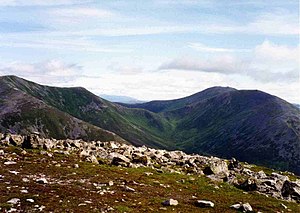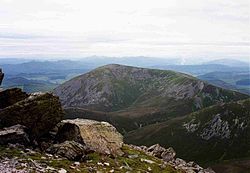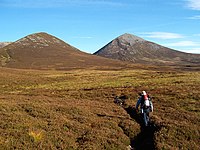Beinn a' Ghlò: Difference between revisions
No edit summary |
mNo edit summary |
||
| (2 intermediate revisions by the same user not shown) | |||
| Line 7: | Line 7: | ||
|picture caption=Bràigh Coire Chruinn-bhalgain (L) and Càrn nan Gabhar (R) | |picture caption=Bràigh Coire Chruinn-bhalgain (L) and Càrn nan Gabhar (R) | ||
|height=3,678 feet | |height=3,678 feet | ||
|os grid ref=NN971733 | |os grid ref=NN971733 | ||
|latitude=56.8398 | |||
|longitude=-3.6869 | |||
}} | }} | ||
'''Beinn a' Ghlò''' is a mountain in [[Perthshire]], amongst the [[Tarf and Tilt Hills]], which reaches a height of 3,678 feet at its summit. It is a triple-Munro, in that three peaks on the mountain are high enough and distinct enough to be listed as [[Munro]]s in their own right: | '''Beinn a' Ghlò''' is a mountain in [[Perthshire]], amongst the [[Tarf and Tilt Hills]], which reaches a height of 3,678 feet at its summit. It is a triple-Munro, in that three peaks on the mountain are high enough and distinct enough to be listed as [[Munro]]s in their own right: | ||
| Line 15: | Line 16: | ||
The three summits which are listed as Munros are: | The three summits which are listed as Munros are: | ||
*'''Carn nan Gabhar''' ('Cairn of the Goats', the highest summit), {{map|NN970732}}, 3,678 feet | *'''Carn nan Gabhar''' ('Cairn of the Goats', the highest summit), {{map|NN970732}}, 3,678 feet | ||
*'''Càrn Liath''' ('Grey Cairn'), | *'''Càrn Liath''' ('Grey Cairn'), 3,199 ft | ||
*'''Bràigh Coire Chruinn-bhalgain''' ('Brae of the Corrie of Round Blisters', | *'''Bràigh Coire Chruinn-bhalgain''' ('Brae of the Corrie of Round Blisters', 3,510 ft | ||
==Geography== | ==Geography== | ||
[[File:Carn Liath from Airgiod Bheinn.jpg|left|thumb|250px|Càrn Liath from Airgiod Bheinn]] | [[File:Carn Liath from Airgiod Bheinn.jpg|left|thumb|250px|Càrn Liath from Airgiod Bheinn]] | ||
'''Beinn a’ Ghlò''' stands some | '''Beinn a’ Ghlò''' stands some six miles north-east of [[Blair Atholl]] in the Forest of Atholl, between [[Glen Tilt]] and Glen Loch. It is a huge, complex hill with many ridges, summits and corries, covering approximately 15 square miles and containing in this bulk three [[Munro]]s. | ||
The mountain has patches of grey scree amongst grass, while heather grows quite profusely on the lower slopes and gives the hill a colourful skirt when in bloom in Summer. | The mountain has patches of grey scree amongst grass, while heather grows quite profusely on the lower slopes and gives the hill a colourful skirt when in bloom in Summer. | ||
| Line 26: | Line 27: | ||
Beinn a' Ghlò has such a diversity of flora that it has been declared a Site of Special Scientific Interest and a Special Area of Conservation over its area. It is a region of European dry heaths and there are many species of alpine and marsh plants on the mountain such as the rare yellow oxytropis ''(Oxytropis campestris)'', mountain avens ''(Dryas octopetala)'', rock speedwell ''(Veronica fruticans)'', rock sedge ''Carex rupestris'' and green spleenwort ''(Asplenium viride)''. | Beinn a' Ghlò has such a diversity of flora that it has been declared a Site of Special Scientific Interest and a Special Area of Conservation over its area. It is a region of European dry heaths and there are many species of alpine and marsh plants on the mountain such as the rare yellow oxytropis ''(Oxytropis campestris)'', mountain avens ''(Dryas octopetala)'', rock speedwell ''(Veronica fruticans)'', rock sedge ''Carex rupestris'' and green spleenwort ''(Asplenium viride)''. | ||
Beinn a' Ghlò is a familiar sight to motorists travelling north along the A9 road at the Pass of [[Killiecrankie]] but this view only shows Càrn Liath. The main mass of the mountain is hidden behind with, the highest and most distant Munro, Càrn nan Gabhar more than | Beinn a' Ghlò is a familiar sight to motorists travelling north along the A9 road at the Pass of [[Killiecrankie]] but this view only shows Càrn Liath. The main mass of the mountain is hidden behind with, the highest and most distant Munro, Càrn nan Gabhar more than 7½ miles from Blair Atholl, so it is a full day's expedition to climb all three Munros. Beinn a' Ghlò has nineteen corries and legend says that a rifle shot in any one cannot be heard in any of the others. Queen Victoria viewed the mountain in 1844 on a drive up Glen Tilt, and wrote: | ||
{{cquote|We came upon a lovely view — Beinn a' Ghlò straight before us — and under these high hills the River Tilt gushing and winding over stones and slates … and the air so pure and fine but no description can do it justice.}} | {{cquote|We came upon a lovely view — Beinn a' Ghlò straight before us — and under these high hills the River Tilt gushing and winding over stones and slates … and the air so pure and fine but no description can do it justice.}} | ||
{{clear}} | {{clear}} | ||
[[File:The path to Carn nan Gabhar - geograph.org.uk - 578839.jpg|right|thumb|200px|The path to Carn nan Gabhar]] | [[File:The path to Carn nan Gabhar - geograph.org.uk - 578839.jpg|right|thumb|200px|The path to Carn nan Gabhar]] | ||
There are two popular starting points for the traverse of the mountain. The first is at Loch Moraig (grid reference {{map|NN905670}}) at the end of the minor road, | There are two popular starting points for the traverse of the mountain. The first is at Loch Moraig (grid reference {{map|NN905670}}) at the end of the minor road, two miles from Blair Atholl. The other is at Marble Lodge in Glen Tilt (grid reference {{map|NN898717}}) but this requires permission from the Atholl Estate to drive the 4½ miles up the private estate road. From Loch Moraig a track is followed to the foot of the mountain. It is a steep climb to the first Munro of Càrn Liath passing through white granite scree near the top. The route continues north dropping down to a col at 760 metres to climb Bràigh Coire Chruinn-bhalgain which gives a fine view down into Glen Tilt before turning east to take in Càrn nan Gabhar. The return to Loch Moraig can be varied, going over the "top" of '''Airgiod Bheinn''' (3,481 ft), which translates as 'Silver Mountain', before dropping into the valley and picking up the track; this avoids the need to re-ascend the first two Munros. | ||
Càrn Liath and Càrn nan Gabhar both have trig points and are excellent viewpoints. Càrn nan Gabhar’s highest point is not actually at the trig point, it is at a cairn 200 yards | Càrn Liath and Càrn nan Gabhar both have trig points and are excellent viewpoints. Càrn nan Gabhar’s highest point is not actually at the trig point, it is at a cairn 200 yards north-east with a height of 3,704 ft (30 feet more than the trig point). | ||
Càrn nan Gabhar has a panorama that includes the [[Cairngorms]], the Glen Shee hills and an aerial view down into Glen Loch. Càrn Liath looks out over Blair Atholl towards the Lowlands. | Càrn nan Gabhar has a panorama that includes the [[Cairngorms]], the Glen Shee hills and an aerial view down into Glen Loch. Càrn Liath looks out over Blair Atholl towards the Lowlands. | ||
Latest revision as of 17:48, 11 April 2024
| Beinn a' Ghlo | |||
| Perthshire | |||
|---|---|---|---|
 Bràigh Coire Chruinn-bhalgain (L) and Càrn nan Gabhar (R) | |||
| Range: | Tarf and Tilt Hills | ||
| Summit: | 3,678 feet NN971733 56°50’23"N, 3°41’13"W | ||
Beinn a' Ghlò is a mountain in Perthshire, amongst the Tarf and Tilt Hills, which reaches a height of 3,678 feet at its summit. It is a triple-Munro, in that three peaks on the mountain are high enough and distinct enough to be listed as Munros in their own right:
Three Munros
The three summits which are listed as Munros are:
- Carn nan Gabhar ('Cairn of the Goats', the highest summit), NN970732, 3,678 feet
- Càrn Liath ('Grey Cairn'), 3,199 ft
- Bràigh Coire Chruinn-bhalgain ('Brae of the Corrie of Round Blisters', 3,510 ft
Geography

Beinn a’ Ghlò stands some six miles north-east of Blair Atholl in the Forest of Atholl, between Glen Tilt and Glen Loch. It is a huge, complex hill with many ridges, summits and corries, covering approximately 15 square miles and containing in this bulk three Munros.
The mountain has patches of grey scree amongst grass, while heather grows quite profusely on the lower slopes and gives the hill a colourful skirt when in bloom in Summer.
Beinn a' Ghlò has such a diversity of flora that it has been declared a Site of Special Scientific Interest and a Special Area of Conservation over its area. It is a region of European dry heaths and there are many species of alpine and marsh plants on the mountain such as the rare yellow oxytropis (Oxytropis campestris), mountain avens (Dryas octopetala), rock speedwell (Veronica fruticans), rock sedge Carex rupestris and green spleenwort (Asplenium viride).
Beinn a' Ghlò is a familiar sight to motorists travelling north along the A9 road at the Pass of Killiecrankie but this view only shows Càrn Liath. The main mass of the mountain is hidden behind with, the highest and most distant Munro, Càrn nan Gabhar more than 7½ miles from Blair Atholl, so it is a full day's expedition to climb all three Munros. Beinn a' Ghlò has nineteen corries and legend says that a rifle shot in any one cannot be heard in any of the others. Queen Victoria viewed the mountain in 1844 on a drive up Glen Tilt, and wrote:
| “ | We came upon a lovely view — Beinn a' Ghlò straight before us — and under these high hills the River Tilt gushing and winding over stones and slates … and the air so pure and fine but no description can do it justice. | ” |

There are two popular starting points for the traverse of the mountain. The first is at Loch Moraig (grid reference NN905670) at the end of the minor road, two miles from Blair Atholl. The other is at Marble Lodge in Glen Tilt (grid reference NN898717) but this requires permission from the Atholl Estate to drive the 4½ miles up the private estate road. From Loch Moraig a track is followed to the foot of the mountain. It is a steep climb to the first Munro of Càrn Liath passing through white granite scree near the top. The route continues north dropping down to a col at 760 metres to climb Bràigh Coire Chruinn-bhalgain which gives a fine view down into Glen Tilt before turning east to take in Càrn nan Gabhar. The return to Loch Moraig can be varied, going over the "top" of Airgiod Bheinn (3,481 ft), which translates as 'Silver Mountain', before dropping into the valley and picking up the track; this avoids the need to re-ascend the first two Munros.
Càrn Liath and Càrn nan Gabhar both have trig points and are excellent viewpoints. Càrn nan Gabhar’s highest point is not actually at the trig point, it is at a cairn 200 yards north-east with a height of 3,704 ft (30 feet more than the trig point).
Càrn nan Gabhar has a panorama that includes the Cairngorms, the Glen Shee hills and an aerial view down into Glen Loch. Càrn Liath looks out over Blair Atholl towards the Lowlands.
References
- The Munros (SMC Guide) Donald Bennett et al., ISBN 0-907521-13-4
- 100 Best Routes on Scottish Mountains, Ralph Storer, ISBN 0-7515-0300-2
- The High Mountains of Britain and Ireland, Irvine Butterfield, ISBN 0-906371-30-9
- SSSI Info
| Munros in SMC Area SMC Section 6 - Glen Garry to Braemar |
|---|
|
An Sgarsoch • An Socach • Beinn Dearg • Beinn Iutharn Mhòr • Beinn a' Ghlò • Càrn a' Chlamain • Carn a' Gheoidh • Càrn an Fhidhleir • Carn an Righ • Carn Aosda • Càrn Bhac • Beinn a' Ghlò • Beinn a' Ghlò • Glas Tulaichean • The Cairnwell |